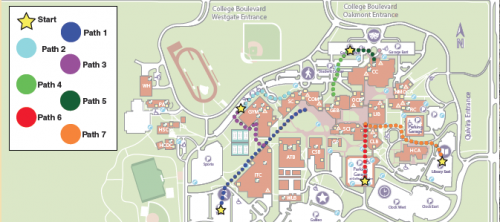With the average cost of a parking space nearing several thousand dollars, students may find it hard to believe the pavement below them costs as much as their car parked on top of it.
Currently the college has around 5,000 parking spaces, according to Ryan Wing, senior sustainability data and research analyst. To build new infrastructures, it would cost around $4,000 for each surface parking space and around $15,000 for each parking space in a garage.
The college’s sustainability department, along with an engineering firm, conducted studies in 2011 to learn more about the parking situation, Wing said.
Elements of this project included tracking how many cars drive to campus each day, when most students arrive for classes as well as the capacity of the parking lots at various times throughout the day.
“The conclusions that we drew from this was we really need to reduce daily vehicles and break that relationship between adding a student and adding a car because that’s kind of an unsustainable relationship and ratio to try to maintain,” Wing said.
With an average enrollment increase of two percent a year, Wing said the college can’t afford to keep building new lots. This would only provide a temporary fix, whereas he said the college needs to look at a more long-term solution.
One of the proposed ideas is for a park-and-ride bus system using the JO. Students would be able to park at a variety of stops around Johnson County and ride to campus for free with their student I.D., with buses arriving and departing from campus every 30 minutes.
“We think this system […] has the potential to open up the college to a lot more people that might not otherwise be able to attend school here,” Wing said.
The program would cost around $1.5 million a year to operate, but Wing said the JO indicated they would cover a portion of the cost. This would possibly leave the college with a cost of around $1 million a year for the system.
Another option that has been discussed is the possibility of parking permits. However, Wing said they have recommended that the college not charge for parking until there is an alternative in place, such as the bus system.
“Right now, really the only feasible way for students to get to and from JCCC is a car,” Wing said. “So, what we have said is don’t do that unless there’s some other option for students because otherwise you are just adding cost and discouraging students from coming here.”
A carpooling program through the college’s recently-approved policy is another possibility, according to Wing. There would be reserved, close-up parking for students who come to class together. Currently, there are no carpool parking spaces on the main campus, but the Olathe Health Education Center, which is run by the college, already has a system in place.
Dwight Rhodes, campus police officer, helped to develop the college’s carpooling policy.
“I think a few would [use the carpool spaces],” Rhodes said. “The policy was written with the future in mind because when we build another building or we may designate some other spots that way later on, on campus.”
The parking spots also help buildings earn points from the U.S. Building Council to become LEED (Leadership in Energy & Environmental Design) certified.
Wing said the college can also consider non-transportation based solutions. For example, readjusting class schedules in order to avoid peaks and more evenly distribute cars throughout the day. Also, Wing described the possibility of using the college’s satellite locations for classes and hybrid-online courses where students may come to campus once a week while completing the other work via the Internet.
“None of those are going to solve the problem by themselves,” Wing said. “It just kind of has to be an all of the above; the bus system has the potential to be the biggest impact as far as providing a solution to the most people.”
Until then, Ed Vesey, campus parking enforcement officer, said he believes students should become familiar with existing parking areas, utilize the outer lots and “get used to walking.”
Vesey said he has also seen an increase in the number of bicyclists at the college this year.
“You see more bikes on campus, which is another option, provided that they’re careful, because there’s a lot of car traffic,” Vesey said. “You’ll see when classes are starting and ending that people tend to be in a hurry so the bicyclists need to be aware of that.”
Also, Wing said he could see a campus bike share program happening “very quickly” if students got behind the idea. This would allow students to ride and park bikes all over campus, instead of walking.
The carpooling program could also be “quickly” implemented. However, the bus system would require more of a push.
“I just think it kind of needs that pressure and or students to say, ‘Hey this makes a lot of sense, I wish I could take a bus to campus rather than driving a car,’” Wing said. “But until there is pressure put on to make that decision, it’s a little bit of a wait-and-see game and wait for the timing to be right.”
Contact Stephen Cook, editor-in-chief, at scook35@ jccc.edu.






















